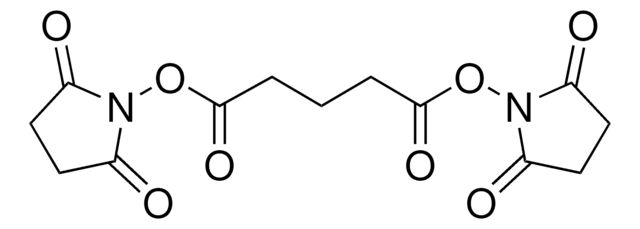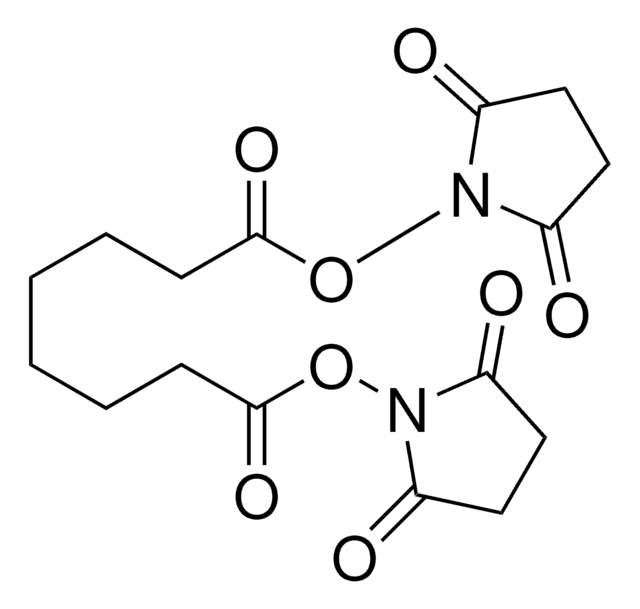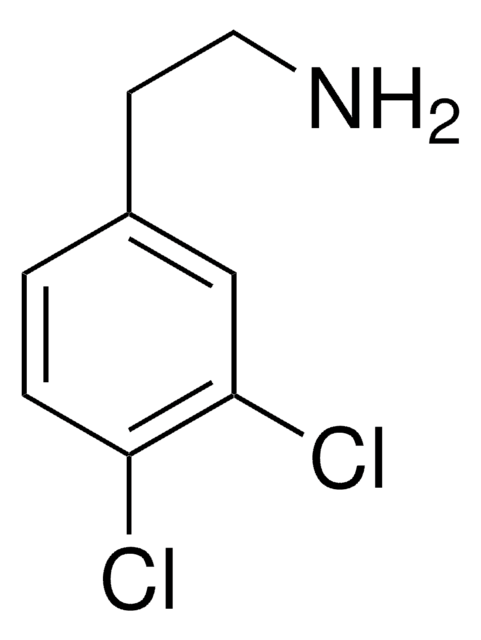Wichtige Dokumente
803537
Bis(NHS)PEG5
Synonym(e):
Bis-N-succinimidyl-(pentaethylene glycol) ester, Bis-succinimide ester-activated PEG compound
About This Item
Empfohlene Produkte
Form
liquid
Qualitätsniveau
Mol-Gew.
532.5
Eignung der Reaktion
reagent type: cross-linking reagent
Lagerbedingungen
desiccated
Löslichkeit
water: soluble
Versandbedingung
ambient
Lagertemp.
−20°C
Verwandte Kategorien
Allgemeine Beschreibung
Leistungsmerkmale und Vorteile
- Reactive groups: NHS ester (both ends)
- Reactive towards: amino groups (primary amines)
- NHS esters react with—NH2 groups at pH 7-9, forming stable amide bonds
- Water-soluble; compare to non-pegylated BS3 (also soluble) and DSS (water-insoluble)
- Membrane-impermeable, allowing for cell surface labeling
- Irreversibly crosslink proteins or peptides by flexible PEG spacer arms
- Polyethylene glycol spacer arms help maintain conjugate solubility
- Pure compound with defined structure and molecular weight, ensuring reproducible protein-modification effects
- PEG spacer provides unique advantages, including increased stability, reduced tendency toward aggregation and reduced immunogenicity
- Ideal for small molecule or peptide conjugations
Vorsicht
Lagerklassenschlüssel
10 - Combustible liquids
WGK
WGK 3
Flammpunkt (°F)
Not applicable
Flammpunkt (°C)
Not applicable
Hier finden Sie alle aktuellen Versionen:
Analysenzertifikate (COA)
Die passende Version wird nicht angezeigt?
Wenn Sie eine bestimmte Version benötigen, können Sie anhand der Lot- oder Chargennummer nach einem spezifischen Zertifikat suchen.
Besitzen Sie dieses Produkt bereits?
In der Dokumentenbibliothek finden Sie die Dokumentation zu den Produkten, die Sie kürzlich erworben haben.
Kunden haben sich ebenfalls angesehen
Unser Team von Wissenschaftlern verfügt über Erfahrung in allen Forschungsbereichen einschließlich Life Science, Materialwissenschaften, chemischer Synthese, Chromatographie, Analytik und vielen mehr..
Setzen Sie sich mit dem technischen Dienst in Verbindung.




![O,O′-Bis-[2-(N-succinimidyl-succinylamino)-ethyl]-polyethylenglykol 2,000](/deepweb/assets/sigmaaldrich/product/structures/161/408/20f7ade0-3e2e-4861-ae89-3d81c050059a/640/20f7ade0-3e2e-4861-ae89-3d81c050059a.png)






